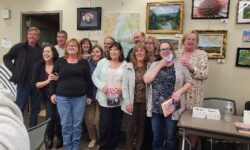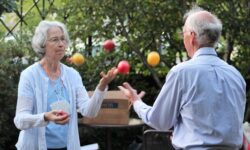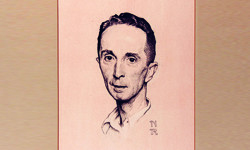[ccfic caption-text format="plaintext"]
By Laura Drinan
Hometown Weekly Reporter
What is art?
Well, there is no easy answer.
Beth Knaus of ArtMatters showed various forms of art since the 1950s as she concluded her three part art series, American Art, hosted by the Friends of the Walpole Library in the library’s Community Room. Before beginning, Knaus warned her audience to have an open mind, as the event would feature a lot of experimental and exploratory art. The event provoked the audience to evaluate their own emotions while looking at each piece of art and considering how each piece could be art.

Beth Knaus talks about sculptures and installations during her final part of her three part series, American Art. Photos by Laura Drinan
Knaus continued to the 1960s and 70s, during which time optical art gained popularity. She showed Victor Vaserly’s “Cheyt M,” which resembled a computer screensaver, and Bridget Riley’s “Current,” which utilized advanced techniques to create fine, wavy lines. Knaus also talked about installations and sculptures by the artists Louise Nevelson and Alexander Calder. Next, Knaus showed some more abstract pieces, including Jackson Pollock and abstract expressionist Willem de Kooning’s “Woman I,” which presents the image of a monstrous-looking woman. “Expressionists use color to express how they feel while they’re painting,” said Knaus, while pointing out the various colors in “Woman I.”

Art fanatics get a closer look at the pieces mentioned by Knaus during the final part of her series, American Art. Photos by Laura Drinan
Knaus also encouraged some of the older members of the audience as she spoke about Grandma Moses, an American artist who began her painting career at the age of 78. Knaus threw in that she completed over 200 paintings after turning 100 years old. The event wrapped up with pieces of photo-realism from Richard Estes and George Segal, sensory imagery from Western MA’s Scott Prior, and street art. Knaus recounted the history of two famous street artists, Keith Haring, who became a prominent AIDS awareness artist, and Jean-Michel Basquiat, who quickly struck stardom after being homeless for several years.
“People ask me: Who are the artists now? And I say, we don’t really know because they’re alive,” said Knaus, laughing. To finish the American Art series, Knaus encouraged her audience to buy from a living artist if they react to the piece and to support artists who are still producing work.
























